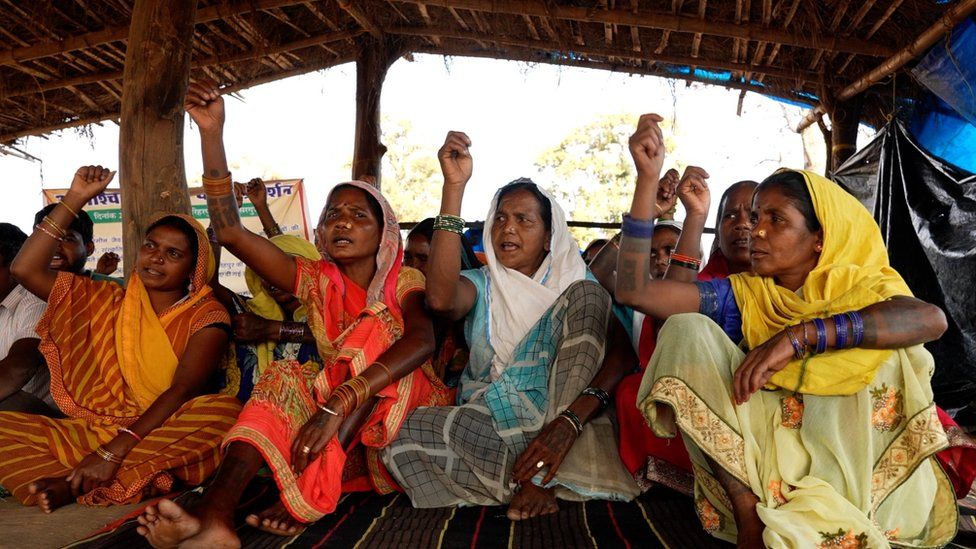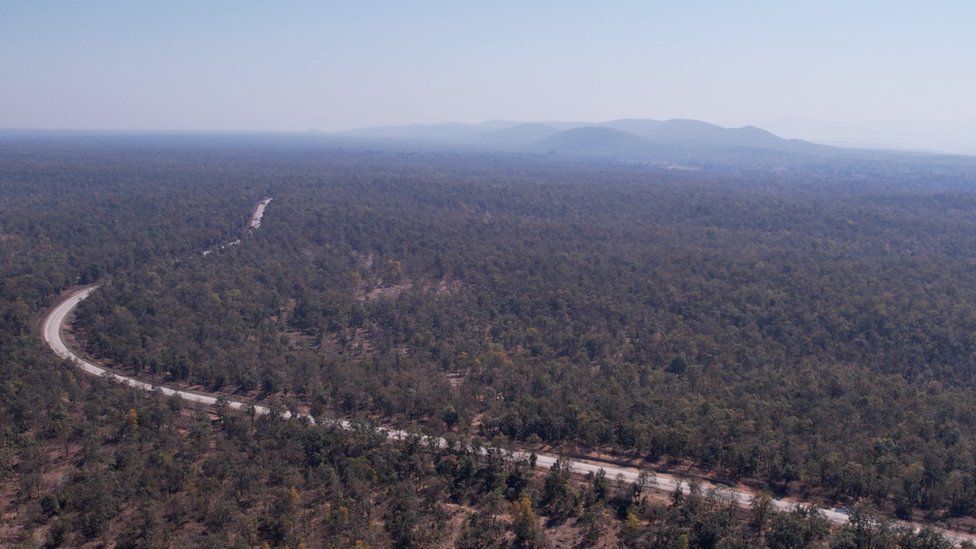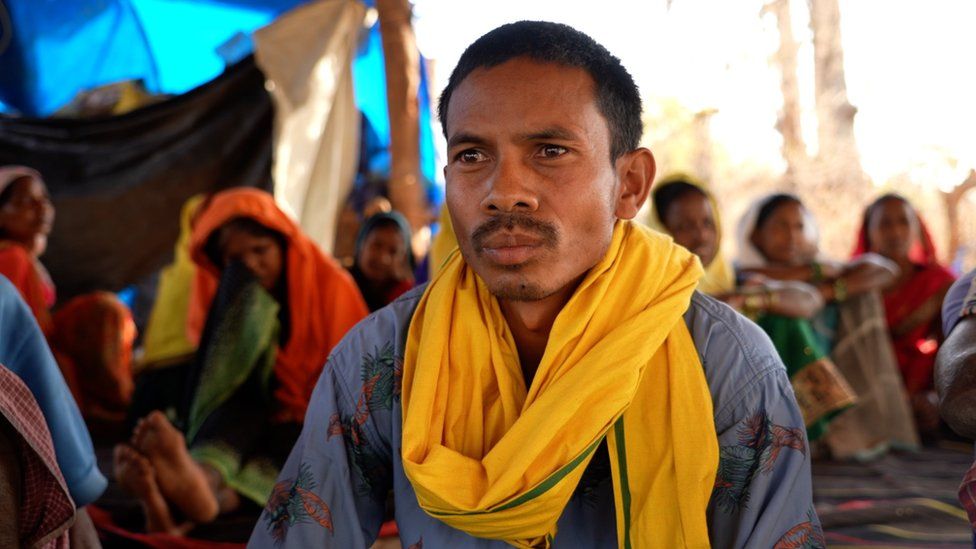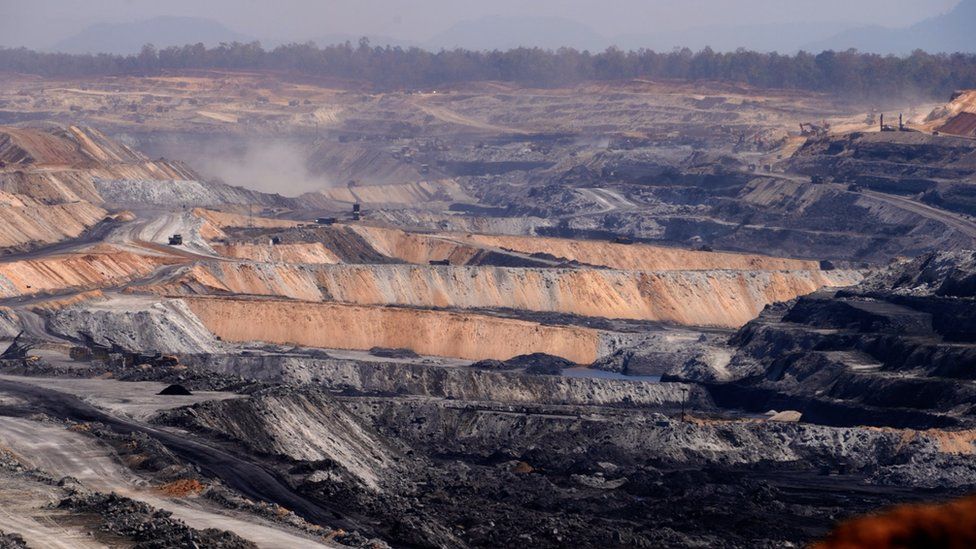
Deep in the jungles of central India, forest-dwelling tribes are marking the one-year anniversary of a continuous agitation against a new coal mine owned by the Adani Group. In recent months, they’ve received a show of support from high-profile politicians and celebrity activists. But in this David vs Goliath battle, a victory for the tribes will be hard won.
The village of Hariharpur in the state of Chhattisgarh stands on the precipice of two discordant worlds. To its east, the myriad greys of the decade-old Parsa East Kete Basan (PEKB) open cast coal mine, operated by the Adani Group, stretch as far as the eye can see. To the other side of this hamlet of a few scattered homes, lies the sprawling expanse of the Hasdeo forest, under which billions of tons of power grade coal still rests unexplored.
These woods are said to be the largest contiguous stretch of dense forestland in central India, spanning 170,000 hectares or 170 sq km (656.3 sq miles) and often called the “lungs of Chhattisgarh”. They are also home to the proposed Lemru Elephant Reserve.
Tribal villagers here have strenuously opposed the proposed opening of the new coal mine for over a decade. But despite staunch resistance and warnings from the government’s own forest research agency of a negative impact on the local habitat and forest ecology, final clearances for the mine were granted last year, triggering an indefinite agitation that’s gone on every day since 2 March 2022.
Interestingly, it is the Congress-led Chhattisgarh government, which has time and again taken on Prime Minister Narendra Modi and his Bharatiya Janata Party (BJP) for favouring the Adani group, which has given this project the go-ahead.
Mounting resistance
A thatched tent off the driveway that leads to Hariharpur has been the epicentre of the continuing tribal protests for the past year. Every day, villagers from the three nearby hamlets of Fatehpur, Ghatbarra and Salhi hold peaceful sit-in demonstrations here.
Once a week, hundreds mobilise to chant slogans, imploring Adani to “go back”.

“The authorities acquired our land illegally by submitting forged documents of the village council meeting. We had never consented to land acquisition,” Muneshwar Singh Porte, member of the Hasdeo Arand Bachao Sangharsh Samiti resistance group told the BBC.
The Chhattisgarh government didn’t respond to the BBC’s query. But the Adani Group refuted these allegations, saying it had always conducted its operations “in total compliance within the laws of the land”.
It said the Rajasthan Rajya Vidyut Utpadan Nigam (RRVUNL), which owns both the existing and proposed mines (along with the Adani group as the mine developer and operator and majority shareholder with a 74% share), handles land acquisition, rehabilitation and resettlement of people within “stringent legal and regulatory frameworks” and had “duly conducted and recorded the process” of getting villagers’ consent.
But across the villages we travelled to, the protesting tribes alleged that the views of the village councils or gram sabhas – mandatory for consideration by law in remote, tribal areas like the Hasdeo Arand region – were either repeatedly violated or sidestepped.
People from at least three villages have petitioned the district administration, seeking an investigation into these violations. The papers, which the BBC has been able to obtain, are also part of an appeal being heard in the Supreme Court against land and environmental clearances granted to the project.

“These forests are where our deities live; we don’t worship idols. Mining will destroy our ancient traditions and way of life,” Ramlal Karyam, a protester said. He and several others had walked 300km to the state capital, Raipur, to demand a halt in mining activity in 2021.
Growing differences
Getting these testimonies on camera isn’t easy. As the protests here reach a tipping point, the forest has become a surveillance zone.
Throughout our two days in these jungles, we were followed around by people on bikes and SUVs. Some threaten to break our vehicle as we try to enter one of the villages – Ghatbarra – to speak to its headman.
These are young men from within the community, fiercely in favour of mining development, and while still in a minority, their voices appear to have become increasingly louder.
“For there to be progress, there will have to be some destruction,” said Keshav Singh Porte, a resident of Fatehpur village, who along with two other men circled our car on a narrow road leading to Ghatbarra.
“We have bigger aspirations than foraging for forest produce,” he added, saying there was a need to “balance the narrative” around the protests.
On our way to another village, Chandra Kumar and his brother try to stop our car.
Mr Kumar admitted that he works as a technician at the existing mine Adani Group mine and said the company had brought several positive developments to the villages, including a school, water and healthcare facilities.
The Adani Group told the BBC they had undertaken a slew of initiatives for the empowerment of the locals which included setting up a school for nearly 800 students, training over 4,000 youth in vocational activities and managing local mobile clinics among other things.
It also said the PEKB mine, which has been producing coal since 2013 to meet RRVUNL’s fuel requirements, has alone generated “over 15,000 direct and indirect employment opportunities in the district” and this “could not have been possible without the strong support from locals”.
Several villagers and activists, however, allege that positively engaging with the community was a way for Adani to persuade them to drop their protest. They claimed the company had recruited young men in every hamlet across the forest to keep a watch on their activities and prevent the resistance from spiralling out of control.
Turning tide
For a short while last year, it appeared like the tribes were getting their voices heard.
One of India’s most prominent politicians Rahul Gandhi openly expressed disagreement with his own party’s decision in the state to allow mining in the region.
Just last month, the most visible face of India’s farmers protests, Rakesh Tikait, declared that protests would intensify if a single tree was felled.

The Congress even wrote to the federal government asking it to rollback the mining clearances.
But Alok Shukla, a prominent social activist in the region calls this a “delaying tactic” by the state government. He says the state has the constitutional right to withdraw the clearances and doesn’t need permissions from the federal government.
Chhattisgarh “lacks the political will” to act quickly because there’s pressure from the Rajasthan government, another-Congress ruled state whose electricity generation company will eventually receive coal from Parsa, he adds.
Elections are also round the corner in Chhattisgarh, which complicates the political environment. And a long, hot summer, with the spectre of blackouts will heighten politicians’ focus on energy security.
The Supreme Court has refused to stay the project, saying that the pending petitions challenging land acquisition cannot be treated as any kind of restriction against mining, and that the rights of the tribes will be determined separately but “not at the cost of development”.
But the protesters are confident they will prevail.
“We have faith in the courts,” said Umeshwar Singh Armo, a prominent member of the resistance group. “This isn’t just a fight for Hasdeo. We are fighting for this country and for the world, which is staring at the dangers of climate change and environmental degradation.”

Read more India stories from the BBC:
- A tiny tool Indian women use to fight sexual harassment
- India steps up search for Sikh separatist preacher
- Gandhi told to give police details of Kashmir claims
- Bollywood’s complex relationship with paparazzi
- Indian students face exit from Canada over fake papers
- A 1970s film on love and envy that is still relevant

